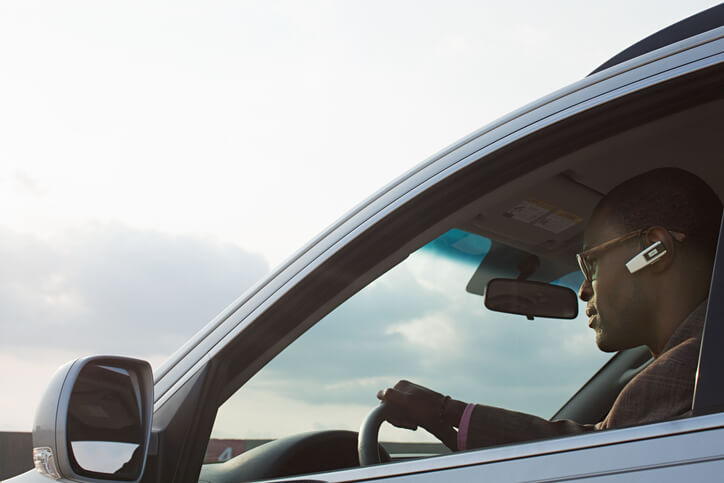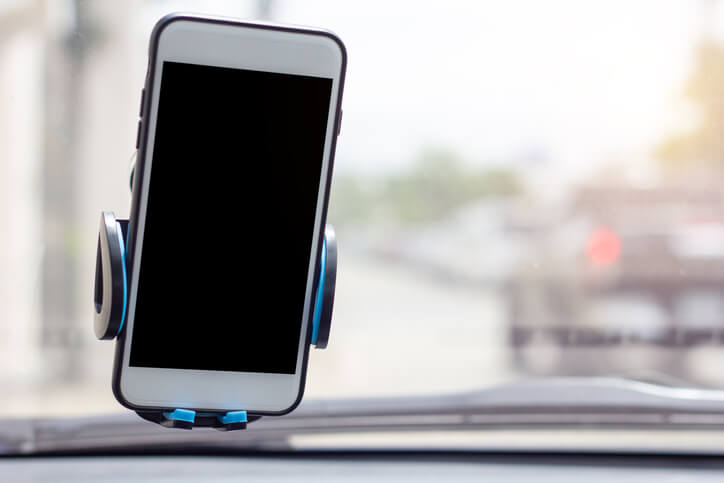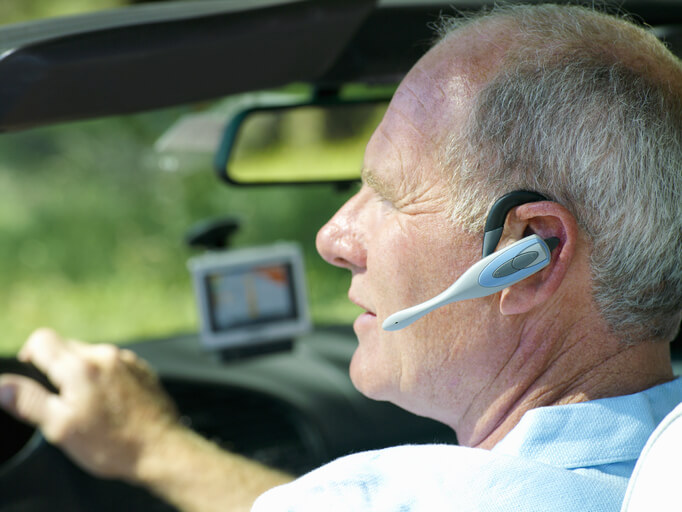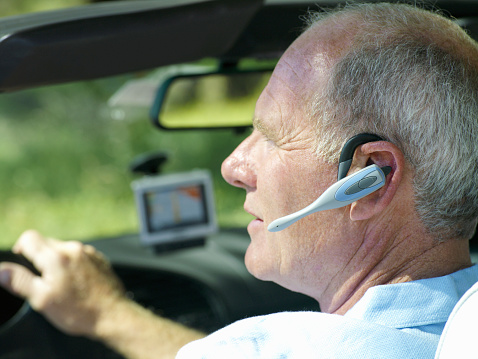Think your hands free device makes it safer to use your cell phone while driving? Think again. As it turns out, hands free devices can still be a distraction, and although handsfree is still better than handheld, both can lead to distracted driving.
Cell phone use is just one of many culprits that lead to distracted driving, but in recent years, it has contributed to a growing number of crashes. According to the National Safety Council, distracted driving kills 9 people and causes more than 1,000 crashes every day, making distracted driving a serious problem. While hands free is better than handheld, both are still distracting. That’s largely because of the limitations of the human brain: our brains simply can’t do everything we may expect of them at the same time.
Why a Hands Free Device May Not Make You Safer

Car Bluetooth devices are commonplace for most drivers, which means there’s less reason to use a handheld device while driving. The use of handheld devices while driving limits a driver’s ability to operate a vehicle properly, but do Bluetooth devices solve that issue? Recent research shows that having your hands free isn’t the only thing that matters for safety. It’s equally important to have your mind free of distractions while driving.
A study published by the University of Sussex in England found that talking on the phone, even with a hands free device, requires much of the same brain processing resources needed for driving. Doing both at the same time caused participants in the study to detect fewer hazards, respond to hazards more slowly and fail to register seeing things that were right in front of them.
Focus & Hands Free Devices While Driving
If you’ve ever been irritated by a family member who appears to tune out your voice while reading the newspaper or attend to a crying grandchild, you may be surprised to learn that they may not be purposefully ignoring you. Instead, their brain may be unable to pay attention to what you’re saying while focused on the newspaper or a small child’s whines. That’s because our brains aren’t the best at multitasking. You need a certain amount of focus for every task, and that focus may not go as far as you think.
Through extensive study, researchers have found that attention is a limited resource. Each person only has a certain amount of attention available, and when focusing his or her attention on one thing, he or she is unable to focus on others. Nobody can attend to everything at once, so when we apply our attention resources to one thing, we are always doing so at the expense of other things.
Our senses have some attention resources, but they can also interfere with each other. For instance, if you’re looking at something (paying attention to a visual task), you may be able to listen to something else (paying attention to an auditory task) more easily than you could focus on looking at something else. That’s why you may feel like you can pay attention to the road in front of you while talking on a cell phone, but not while looking at your navigation system. However, attention to one sense, such as hearing, can impair attention to another, such as vision, says attention researcher Marc Green, Ph.D
A Hands Free Device for Your Car May Not Get Rid of Distractions

If you think having a hands free device for your car gets rid of distractions, you could be mistaken. It all comes down to the way the brain processes information. The human brain has a limited capacity to process visual images simultaneously. Although talking on the phone may seem like it would only require auditory resources—the sense of hearing—it uses up the brain’s visual processing abilities as well. Psychological researchers at The University of Sussex discovered found that talking on the phone – even when it’s handsfree – uses more of the brain’s visual resources than was previously understood.
That’s because when you’re in a conversation, your brain is visualizing what you’re talking about. Someone on the other end of the phone line may ask, “Where did you put the green folder?” This question might cause you to visually imagine the green folder, the room the green folder was in, what the green folder was used for, and several other visual things.
Research shows that a brain does not have enough processing ability to simultaneously imagine images and keep track of what the eyes are seeing, which is a knock against the use of hands free devices while driving. For instance, you may see the trash receptacle in your lane, but because your brain is focused on an intense phone conversation, your brain may not actually register the receptacle until you’re too close to avoid it. Even worse, your brain could be busy processing your phone conversation and the emotions stemmed from it, causing road rage in some cases. This ultimately can contribute to you driving a little faster and cause you to miss the vehicle pulling out into your lane or the child running into the street from your right.
“Conversations are more visual than we might expect, leading drivers to ignore parts of the outside world in favor of their inner visual world, with concerning implications for road safety,” says Graham Hole, a senior lecturer in psychology at the University of Sussex and one of the study’s authors.
By tracking eye movements, the Sussex study found that distracted drivers suffered from “visual tunneling,” which means they tended to focus their eyes on a small, central region directly ahead of them. This type of tunneling led participants to miss hazards in their peripheral vision.
These findings signify dangerous consequences for drivers who use their cell phones, even those that are using a hands free device. While hands free devices are significantly safer than a handheld device, they are still problematic and unsafe. “The only safe phone in a car is one that’s switched off,” Hole says. This will ultimately prevent distracted driving leading to car crashes and other accidents.
For parents of young drivers, it’s important to try and instill habits of distraction-free driving in kids right from the beginning. Try to encourage making the car a phone shutdown zone. Or, if turning off the phone isn’t an option, encourage them to put their device in airplane mode, which essentially turns off the device’s ability to receive calls and texts. There are also ways that parents can monitor their teen’s driving with different apps and devices. For more tips, see our teen driver advice article.
Are You Breaking the Law?

When you use your cell phone behind the wheel, you’re not just endangering yourself, your passengers and others; you may also be breaking the law. That means you could risk getting a ticket or worse, a criminal charge in the case of an accident. Putting down the device can also save you an increase in your insurance premium, as distracted driving can impact your premium.
Fourteen states and the District of Columbia ban handheld cell phone use while driving. No state bans all cell phone use while driving, but 38 states and D.C. do ban all cell phone use by novice drivers, such as those under a certain age or newly licensed. Twenty states also ban all cell phone use for school bus drivers. Texting while driving is almost universally banned: 46 states and D.C. prohibit text messaging for all drivers. While using a handsfree, Bluetooth car device is legal, it should still be treated with extreme caution.
Stay Safe with Hands Free Devices While Driving by Not Using Them
According to the National Safety Council, there are three basic requirements for staying safe while driving: keep your eyes on the road, hands on the wheel and your mind on driving. While practicing these, the number of auto claims will decrease due to distracted driving.
When using a cell phone, whether through hands free devices or handheld, it’s almost impossible to abide by those three requirements. You can help keep yourself, your passengers and others safe by waiting to use your device until you’ve stopped the car.
While it may be tempting to use a hands free device in your car, keep in mind that doing so may jeopardize your own, or someone else’s, safety.
Alternatives to Distracted Driving
Never text in a car. If you must send a text, ask if a passenger can send it for you. Or, if it’s urgent, you might be able to use voice control to send a text, if your car has that functionality. Do not pick up your phone to activate voice text. None of these methods are full proof. If you really need to use your phone, the best way is to pull over, stop the car, and use the phone then.
Use a location-sharing app if you’re planning on meeting your friends for a time-sensitive activity. Some apps will allow you to share your location with friends; that way you won’t have to text your friends if you’re late or stuck in traffic.
Take the Pledge
It’s important to understand the ways to prevent distracted driving. That’s why the National Safety Council established a pledge to try and educate and encourage drivers to avoid distractions while driving. The pledge outlines the different distractions that affect drivers. Distractions listed include:
- Having a phone conversation – handheld, handsfree, or via Bluetooth
- Texting or sending Snapchats
- Using voice-to-text features in my vehicle’s dashboard system
- Updating Facebook, Twitter, Instagram, Vimeo or other social media
- Checking or sending emails
- Taking selfies or filming videos
- Inputting destinations into GPS (while the vehicle is in motion)
- Calling or messaging someone else when I know they are driving
Take the pledge with us to educate more drivers on the dangers of distracted driving. Download and print your certificate here.







I like this page, some useful stuff on here : D.
I have a phone in my truck most of the time it’s for emergency’s,but when I am out and I have been gone all day I will call home to let my husband know where I am on my way.
I love having it that way because my hands are free and I can still concentrate on what I am doing, I do think that’s the best way to be on the phone IF you have to.
Biggest problem I see on the road are drivers that are looking down in their laps on their phones.. That and the fact a high number of people follow too closely to the traffic ahead of the them… It pays to stay far enough away from the traffic ahead of you, that way you will be able to safely stop even though someone is tailgating you.
Put your cell phone in “air plane mode” when driving. Simple as that.
Live’s are at stake,and not just yours. Just “Stop It”!
We seem to forget that driving is a privilege, not a right. A car is a seriuos killing machine when not being driven with complete focus, mindfulness of other drivers. Eyes lookinf at the road ahead, checking all mirriors,(side and rear view). Hands at 2 and 10 on the steering wheel.
May I also add the number od drivers accelerating through RED lights , running them with total disregaurd!
My anxiety level continues to elevate as each day goes by.
Car companies, take all your tech devices out and put them back in homes where they belong.Our cars are not family rooms on wheels, unless perhaps you are traveling in an RV as a passenger.
I just want to stay home anymore. It’s a war out there on the interstate’s, highways and just even driving through ones neighborhood. Parking lots are like the wild. wild west. I hate them!!!
There are individuals I believe capable of using hands-free and some not so capable. That being said, I think hands free only should be allowed. Debates can go on forever on this subject. I would like to hear that more people were getting stopped for cell phone usage (not hands free). I pass quite a few people on their phones going under the speed limit, drifting close to the other lane because they are leaning on their elbows while talking. Insurance companies need to cover damages to vehicles. Cost of insurance is not always affordable but a person hit by a driver texting should be able to receive cost of damages. I have also driven by a woman reading a book across her steering wheel, people reaching into back seats. There should be a non emergency number to call to report these people!
I was a professional driver for over 15 years and I can absolutely say with 100% certainty that using a hands free device is no different than talking with a passenger in your car! I was always against cell phone use while driving and I still am, but that requires physical interaction and hands free does not. Any person that can’t drive and talk to someone should never be issued a license. Every driving instructor talks to their student during the lesson. How do explain that?
Please cancel my policy. Thank you. Send confirmation. Regards
Hi Rick, we’re sorry to hear you’re cancelling. Please call our Customer Service Center at 1-800-423-6789 and one of our representatives can cancel your policy for you. Thank you!
hi already have your auto insurance,but have a problem i lost the proff paper you keep in car need it reaplaced. if yhere is any problem please call me
Hi Russell, you can print out a copy of your ID cards by logging online to our Customer Service Center. If you’d rather speak to a representative, please call our Customer Service Center at 1-800-423-6789 and someone can mail your ID cards to you. Thank you!
I’ve always always said hands-free doesn’t make any difference you should be on a cell phone at all when you’re driving
When I was driving for Greyhound Lines, the art of “Leave plenty of Living Room” was stressed very often in the training classes. What it meant is simply leaving a lot more space between the vehicle in front of you and the front of the bus. Sounds pretty basic doesn’t it? I am retired now, but I still leave plenty of Living Room between my vehicle and the vehicle in front of me.
Back then, there not many cell phones around. I could easily carry on a conversation with a close seated passenger without a problem. Casual conversation with someone else while driving has never caused me to really be distracted. I can’t see why using a cell phone for a casual conversation (Provided that it is a hands free connection) should be any different than talking to someone as a passenger in the vehicle (Provided the driver’s eyes are on the road and NOT at the passenger)
Please keep in mind that a casual conversation does not contain any part of “Road Rage” or a heated argument.
Just food for thought. Use the Greyhound “Leave Plenty of Living Room” as your safety cushion and enjoy your trip, cell phone or no cell phone.
I agree that using a cell phone while driving is always distracting and should be limited. Having said that, I would like to point out something that this article should have addressed, but ignored. I don’t know the statistics of this, but I would guess that the time that a driver is distracted by passengers in the car (think children needing attention, spousal/friends conversation) is at least a hundred if not a thousand times the amount of time a driver is distracted by a cell phone. Now, I am not saying we should outlaw talking while driving (or for that matter listing to a talk show on the radio – which I think is very similar in attention grabbing to a cel”l phone conversation, maybe even worse). But if this article is about safe driving for us seniors, who have worse reflexes than younger age groups and need more driving attention anyway, I think that these much more likely causes of distracted driving should have at least been mentioned and discussed at length.
Roger – Thank you for your comment. We agree with you! Check out our article for nine most common distractions for drivers as reported by the IIHS and tips for mitigating the impact of distractions.
If it’s dangerous to operate a vehicle while using a hands free phone, then it is dangerous to listen to your music or talk to anybody in your vehicle. Another point is to remove all billboards and signs not related to driving along the highways.It’s much more important to remove drugs and alcohol .
My Mom was killed by a driver using their GPS and not noticing that they were coming to an intersection. We still live with the extreme hurt of Mom’s passing – and the anger that comes from being cheated out of all the years we could have had with her just because someone couldn’t take the time to stop the car while entering an address into their GPS.
I so agree with this article and it should be passed on to all friends and family. We are responsible for keeping ourselves and especially others safe while we are out there driving.
There’s really no such thing as “multi-tasking”–at least not simultaneously. The mind can leap back & forth from one mental focus to another, but can’t hold two such focuses simultaneously. And yes, those leaps can be very swift (though a bit swifter with some people than others). It’s good to realize–and to teach our driving-age kids–that at 60 mph, you travel nearly 90 feet per second! To get the concept of 90 feet, measure the length or width of your house, then visualize how many house-lengths that is. Then imagine a deer leaping out at that distance…or a kid…or a vehicle…or the car ahead of you suddenly stopping. Just a single second’s distraction can end your life or someone else’s. . . .
I would submit that driving with a small child, a gabby friend, or siblings arguing is just as distracting as a hands free phone. So, should we ban these causes also? Maybe a Get Smart cone of silence around all these passengers?
When I am driving, I do not use my phone, or even answer it when it rings, THAT’S WHAT VOICE MAIL IS FOR ! When I was in the Army,(many many years ago, Army sedans only had a speedometer gas gauge, temp and oil light. That was it. No radio, cigarette lighter, nothing to distract you. Your job was TO DRIVE ! I wish people today could understand that. Paying attention with common courtesy and and common sense would probably reduce traffic accidents by at least 90%.
My phone does not let me accept messages while driving.
Cell phone rings, let it ring until it is safe to pull over and answer, another choice caller number will be on phone,call back later.
I remember working the night shift as an RN and driving home after my shift without really knowing how I got there. Still happens now to everyone to some degree. You get some place and don’t really remember the details of the drive. There is an automatic part of driving as well is there not? Not trying to justify using cell phones, just more to the story.
Lots of comments. The navigation system and passengers can be distracting. With the automated vehicles, maybe that will help. I have a Chevy Volt and it posts a sign on the display indicating not to look at the display. You have to push OK in order to get radio station selections. That bothers me because I must press that button while I am driving. It comes up about once a month. That is not good. Texting at a stop light does cause accidents. I witnessed that. I don’t do that.
This article is so TRUE. Even though my cell is sinc to my car and when I answer it I do feel at times distracted. I NEVER text nor do I answer a text while driving.
Maybe insurance companies should put their resources behind driverless cars instead of telling us why they are raising the rates.
I have taught “Safe Driving” classes for over 20 years and have found that there have been “driverless” cars on the roads all this time. I am now afraid to back out of the driveway to go grocery shopping!!!!!!!!
I torally agree with this article! I wish laws would be enacted against talking on mobile phones and driving!!!
My phone shuts down the minute I start driving It also shuts down when I am a passenger! Let the Police. Ambulance drivers and fire engines have their phones , get your phone companies to install the same hard ware I have from my phone and problem is solved! Also have insurance companies drop their rates if you have this capability in your phone!
I just bought a smartphone. I’ve had a “dumb” phone for years and loved it. But I wanted GPS and a few other things. I’m just learning to text but would NEVER text while I’m driving! That doesn’t make any sense. There is no text I could type or read that’s more important than my life or the life of another person/animal. And I can talk to people when I get where I’m going. If my family and friends don’t understand, well I guess my life is not as important to them as it is to me….Just drive safe and defensively – bottom line.
The term “distracted” driving is not accurate. The correct term is “mindless” or “brainless” driving. Talking on the phone while driving (hands free or not) occupies longer continuous attention and a far greater portion of your brainpower than changing the radio, adjusting the ac, or talking with a passenger. This is supported by the current study as well as by many other reputable scientific studies. Wake up people! Believe it! It is true!
SCIENCE: Because figuring things out is always better than making stuff up!!!
MS. Jackson,
For many years, as a commercial driver, I used a cell phone and then a smart phone to communicate with dispatchers and others
WITHOUT ANY PROBLEMS !!!
I did not punch buttons while driving, only oral communications.
I also did the same thing as both a military and civilian pilot.
I really do not understand why the average person can’t do the same ?!!!
I suggest that people have a notation on their drivers license ( like for
glasses ) if they truly cannot competently talk on the phone while driving.
Karla Mendoza, not quite the same because if you are paying more attention to the conversation w/passenger than driving, may the passenger will warn you of something happening on the road around you. the person on the other end of the phone would not be able to do so. happened to me a few time when driver was speaking to me and every one in a while looking at me..had to warn them of car making left turn in front of us. And Jim Chidemaster : Pass a law that if you are in an accident and you are texting.insurance will not pay any claims due to being on phone while driving. so you punish (even more) the person who got hit by distracter driver by having the distracted drivers claim rejected?!
What about distractions when the driver is talking to or listening to a passenger in the car? I have seen driver and passenger in an apparent argument where tempers are flaring, and drivers frequently turning their head to speak to a passenger. These are also causing accidents.
I do not use cell phone calls often my car is blue toothed to the phone mostly use when it’s a incoming call also have anti collision in my car and use it all the time set cruse control to speed limit always never above.
I don’t have a cell phone, so I don’t have to worry and its illegal in California where I live
The article should also have included “Navigation Systems” as they are just as distracting! Drivers are more and more relying on these systems, watching the screen, or listening to instructions, and then taking actions with their vehicles, completely oblivious as to anything else around them. Several recent incidents where drivers who had turned onto live railroads tracks “because their navigation system told them to make a turn” bears this out. They were following directions, rather than concentrating on the road and their surroundings.
Eating and non-alcoholic drinking are distractions, often unconsidered.
Thank you for posting this article! In total agreement with its conclusion!
Is it different to talk to the person beside you in the car, or is that just as dangerous?
I know texting should be against the law,but I think it’s ok to answer a quick call on a hand free device while driving, there are some people that can multi task and the brain can do more than one thing,we have to remember you have emergencies that occur,and there are the, physicians, Attorneys and other emergency officials that has to make calls from their vehicles.
Wouldn’t using hands free be the same as talking to your passenger?
There is 100% no excuse on using a phone while driving… driving and Texting/talking is Dangerous..Don’t do it…put your phone away till you have reached a destination to use while stopped and not driving your car/truck….
There is nothing gets my crow faster is to cross a driver, who is texting or one who has got lost in their conversation while driving. In a sense, I question the study. The study was completed in the UK. In the UK the speed limits and driving habits are very different from the United States. In some case what speed limit is below 80 mph with the exception of in town driving. In some areas it would be like driving through downtown New York at a traffic pace of 80 mph. Then I look at police patrol cars where the officer is either on the radio, laptop, or cell phone while the unit is traveling at a normal pace or high speed. I believe there are those, who can not walk and chew bubble gum at the same time, and they should refrain from using a cell phone while driving.
I kind of agree with most of this article but handsfree for me is no different than talking to the passenger next to me. I don’t have an issue with either. However, I’ve been hit from behind twice by people on cell phones. Both times while sitting at a red light. One kid texting and a middle-aged woman I later found out was arguing with her boyfriend. My car is now paid for and my lawyer is happy…
Is talking hands-free more distracting then talking to the person next to you? Does this mean you have to stop talking to the person next to us when driving? Texting it is definitely distracting when driving and so are some of the new dashboards screens with all functions.
But yes talking to anybody can be little distracting but how many of us have done it all our lives. As children to our parents and as drivers talking to friends and family. . Testing is great, but as with so many things test’s and results can be one sided to show the results they are looking for. Use common sense.
I have experienced a close call from a car whose driver was on her phone. The driver was a middle age woman with two children in car seats. I put my cell phone in the back seat turned off so that when I do get home and check I am alive to answer ANYTHING that’s on there. I hope they totally ban any cell phone use while driving. They used to say arrive alive, this still applies to texting also.
Pass a law that if you are in an accident and you are texting.insurance will not pay any claims due to being on phone while driving.that I believe would stop a lot of accidents.
I think this study is false. Because I was just reading this article and listening to my wife and toddler, and heard a screaming baby in the background while also hearing Daniel Tiger play on tv. However, I do think that some people can’t handle all this at once, but others can.
Yes I agree that texting should be banned, but hands free talking no. What I try to do is finish the conversation before I get in the vehicle, but if I need to continue to talk with the person then I stay on the phone. Or if I receive a phone call while driving I try to keep the call short.
Be Aware and Keep Safe!
I do not text while driving and never will……………….
I note that (on my phone) the link opened as a ‘mime attachment’ and did not open my browser & take me here as expected; instead it was necessary to ‘copy’ the link, then open the browser manually & finally paste & go.
Hope that info may be helpful for others.
I never looked at that way when you have a hands free device. I’m not debating about your study, but don’t that depend on the individual. You have some people that already have attention deficit, but at the end of the day it’s best to be safe than sorry.
I bought a new car and trying to learn all of these new fangeled gadgets
scare me. I am getting better. but the phone and text messages are coming
out of the dash board. It even reads them to me. A talking dash board. Hahaha
Grammpa would roll over in his grave to see this one. My son leaves me a text message
and it sounds weird in a woman’s voice.
Too many things to push and think about while I am trying to drive down the seat. Soooooooo
I turn it off and listen to my music and enjoy the ride. (and by the way when you are riding with me
don’t tell me how to drive) You may cause me us to get into an accident.
Thanks I can live with out this until I can get home and stop and then push all thee buttons. Another scary thing is when a voice pops out and tell you in a very loud voice. (You have a text message).
I almost had a heart attack.
Happy driving and pray that whom ever is coming at you wakes up from any distractions before it’s too late.
Texting is not just a “teen” problem. There are millions of employees in company cars and fleet vehicles who try to “multi-task” behind the wheel.
While many states seek to lower distracted driving by increasing penalties, fees and regulations, there is another option. There are anti-texting apps, like AT&T DriveMode which is FREE!
One area that is rarely discussed is that each state has thousands of government vehicles that inspectors, regulators and the agricultural department use as fleet vehicles, but they do not have the technology to diminish distracted driving. I would love to see one state lead by example and use a program, like FleetMode, to block texts, redirect incoming phone calls, and impede all other apps in the State vehicles. If we want our state roads to be safer, let’s start by making our state vehicles safer.